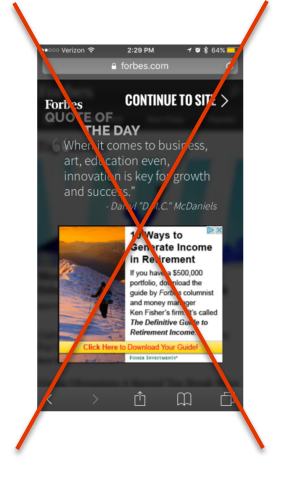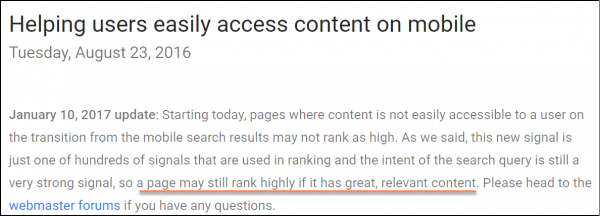Last August, Google announced that, starting January 2017, they would not rank mobile pages as high if the content was visually obscured by an intrusive interstitial or popup. The main reasons Google decided they would start demoting mobile pages with annoying interstitials is because it’s a bad user experience for smaller screens and frustrates users from reaching the content they expect to see.
What Deems an Interstitial as Intrusive?
 An interstitial that blocks the content, disrupting the mobile user experience after immediately clicking a Google mobile search result, is considered intrusive.
An interstitial that blocks the content, disrupting the mobile user experience after immediately clicking a Google mobile search result, is considered intrusive.
- Popups that cover the main content upon load or while scrolling
- Popups that have to be dismissed before displaying the content
- Popups that appear above the fold, so you have to scroll down to see the content below the fold
Exceptions to the Rule
- Popups that appear in between pages
- Popups that are required legally for age verification or cookie usage
- Popups that require you to log in before displaying the content (unindexable or paywalled content)
- Popups that use a reasonable amount of screen space and that are easily dismissible
The Impact, or Lack Thereof
Since the penalty rollout on January 10th, SEOs have reported that Google’s intrusive interstitial algorithm has actually impacted very few sites. Although the reason for so little impact being seen is unclear, Google’s Gary Illyes suggests it could be that Google is not done recrawling the web. I speculate that algo’s lack of bite could be related to the delay in Google’s Mobile-First Index which has been rumored to roll out starting this June and will add more mobile UX factors as ranking signals.
Another thing to keep in mind is that the mobile interstitial algo update is only one of literally hundreds of factors Google uses to determine rankings. According to Google, pages with intrusive popups can still rank well in Google mobile results if relevance signals related to search query intent outweighs the annoying popup.

If your site uses interstitials that are deemed as intrusive and you haven’t noticed any Google mobile traffic declines, it’s likely that Google hasn’t demoted you…yet. You should still consider making them less aggressive and focus on placing them in between pages, rather than page entrances.
If your site doesn’t use interstitials but is planning on it for marketing or legal reasons, design the popup based on Google’s guidelines to avoid being penalized in the future. Besides, you never know when a Google algo goes from bark to bite.
